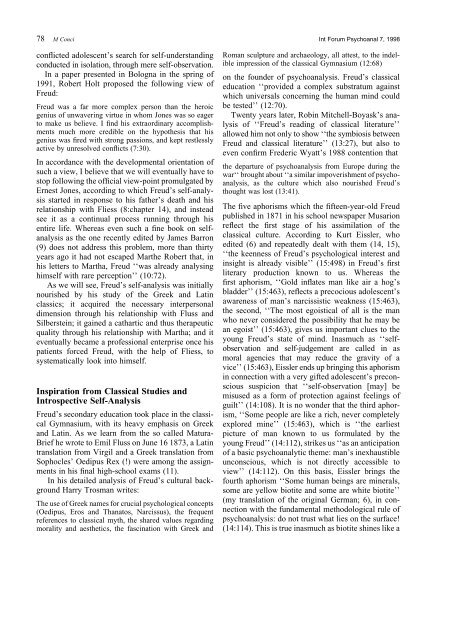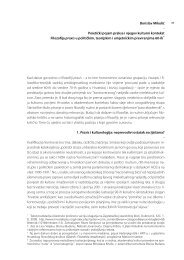Freud's Self-Analysis—An Interpersonally Grounded Process
Freud's Self-Analysis—An Interpersonally Grounded Process
Freud's Self-Analysis—An Interpersonally Grounded Process
You also want an ePaper? Increase the reach of your titles
YUMPU automatically turns print PDFs into web optimized ePapers that Google loves.
78 M Conci Int Forum Psychoanal 7, 1998<br />
conflicted adolescent’s search for self-understanding<br />
conducted in isolation, through mere self-observation.<br />
In a paper presented in Bologna in the spring of<br />
1991, Robert Holt proposed the following view of<br />
Freud:<br />
Freud was a far more complex person than the heroic<br />
genius of unwavering virtue in whom Jones was so eager<br />
to make us believe. I find his extraordinary accomplishments<br />
much more credible on the hypothesis that his<br />
genius was fired with strong passions, and kept restlessly<br />
active by unresolved conflicts (7:30).<br />
In accordance with the developmental orientation of<br />
such a view, I believe that we will eventually have to<br />
stop following the official view-point promulgated by<br />
Ernest Jones, according to which Freud’s self-analysis<br />
started in response to his father’s death and his<br />
relationship with Fliess (8:chapter 14), and instead<br />
see it as a continual process running through his<br />
entire life. Whereas even such a fine book on selfanalysis<br />
as the one recently edited by James Barron<br />
(9) does not address this problem, more than thirty<br />
years ago it had not escaped Marthe Robert that, in<br />
his letters to Martha, Freud ‘‘was already analysing<br />
himself with rare perception’’ (10:72).<br />
As we will see, Freud’s self-analysis was initially<br />
nourished by his study of the Greek and Latin<br />
classics; it acquired the necessary interpersonal<br />
dimension through his relationship with Fluss and<br />
Silberstein; it gained a cathartic and thus therapeutic<br />
quality through his relationship with Martha; and it<br />
eventually became a professional enterprise once his<br />
patients forced Freud, with the help of Fliess, to<br />
systematically look into himself.<br />
Inspiration from Classical Studies and<br />
Introspective <strong>Self</strong>-Analysis<br />
Freud’s secondary education took place in the classical<br />
Gymnasium, with its heavy emphasis on Greek<br />
and Latin. As we learn from the so called Matura-<br />
Brief he wrote to Emil Fluss on June 16 1873, a Latin<br />
translation from Virgil and a Greek translation from<br />
Sophocles’ Oedipus Rex (!) were among the assignments<br />
in his final high-school exams (11).<br />
In his detailed analysis of Freud’s cultural background<br />
Harry Trosman writes:<br />
The use of Greek names for crucial psychological concepts<br />
(Oedipus, Eros and Thanatos, Narcissus), the frequent<br />
references to classical myth, the shared values regarding<br />
morality and aesthetics, the fascination with Greek and<br />
Roman sculpture and archaeology, all attest, to the indelible<br />
impression of the classical Gymnasium (12:68)<br />
on the founder of psychoanalysis. Freud’s classical<br />
education ‘‘provided a complex substratum against<br />
which universals concerning the human mind could<br />
be tested’’ (12:70).<br />
Twenty years later, Robin Mitchell-Boyask’s analysis<br />
of ‘‘Freud’s reading of classical literature’’<br />
allowed him not only to show ‘‘the symbiosis between<br />
Freud and classical literature’’ (13:27), but also to<br />
even confirm Frederic Wyatt’s 1988 contention that<br />
the departure of psychoanalysis from Europe during the<br />
war‘‘ brought about ‘‘a similar impoverishment of psychoanalysis,<br />
as the culture which also nourished Freud’s<br />
thought was lost (13:41).<br />
The five aphorisms which the fifteen-year-old Freud<br />
published in 1871 in his school newspaper Musarion<br />
reflect the first stage of his assimilation of the<br />
classical culture. According to Kurt Eissler, who<br />
edited (6) and repeatedly dealt with them (14, 15),<br />
‘‘the keenness of Freud’s psychological interest and<br />
insight is already visible’’ (15:498) in Freud’s first<br />
literary production known to us. Whereas the<br />
first aphorism, ‘‘Gold inflates man like air a hog’s<br />
bladder’’ (15:463), reflects a precocious adolescent’s<br />
awareness of man’s narcissistic weakness (15:463),<br />
the second, ‘‘The most egoistical of all is the man<br />
who never considered the possibility that he may be<br />
an egoist’’ (15:463), gives us important clues to the<br />
young Freud’s state of mind. Inasmuch as ‘‘selfobservation<br />
and self-judgement are called in as<br />
moral agencies that may reduce the gravity of a<br />
vice’’ (15:463), Eissler ends up bringing this aphorism<br />
in connection with a very gifted adolescent’s preconscious<br />
suspicion that ‘‘self-observation [may] be<br />
misused as a form of protection against feelings of<br />
guilt’’ (14:108). It is no wonder that the third aphorism,<br />
‘‘Some people are like a rich, never completely<br />
explored mine’’ (15:463), which is ‘‘the earliest<br />
picture of man known to us formulated by the<br />
young Freud’’ (14:112), strikes us ‘‘as an anticipation<br />
of a basic psychoanalytic theme: man’s inexhaustible<br />
unconscious, which is not directly accessible to<br />
view’’ (14:112). On this basis, Eissler brings the<br />
fourth aphorism ‘‘Some human beings are minerals,<br />
some are yellow biotite and some are white biotite’’<br />
(my translation of the original German; 6), in connection<br />
with the fundamental methodological rule of<br />
psychoanalysis: do not trust what lies on the surface!<br />
(14:114). This is true inasmuch as biotite shines like a




